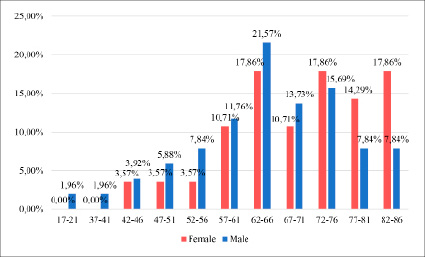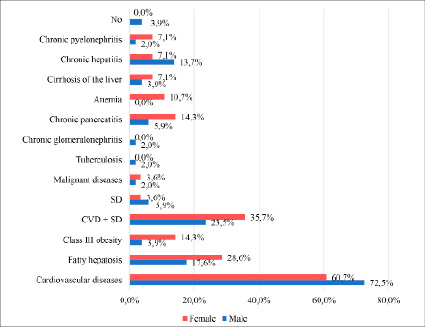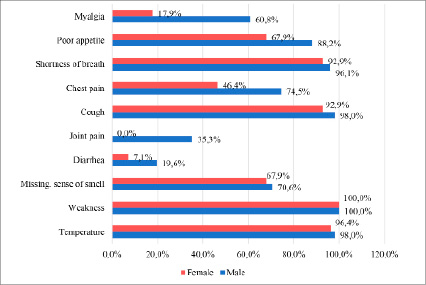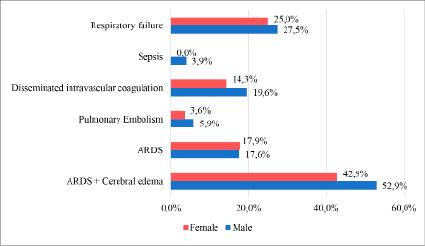The COVID-19 pandemic, having become a global problem and leading to huge human losses, still poses a significant threat to humanity [1, 2]. At the present stage, due to the relevance of the COVID-19 coronavirus infection, further study of the clinical, laboratory and epidemiological features of this disease in the acute period and after infection is carried out [3, 4, 5]. The clinical picture of the disease is characterized by a transition from mild to severe leading to acute distress syndrome and further to lethal exodus [6, 7]. In this regard, it was interesting for us to analyze the clinical manifestations in patients with an unfavorable outcome when infected with SARS-CoV-2.
The purpose of the study was to analyze the clinical indicators of COVID-19 in patients with an unfavorable outcome.
Materials and methods of research
On the basis of the Department of Infectious Diseases of the I.K. Akhunbaev Kyrgyz State Medical Academy, the selection, analysis and discussion of the results of studies of the medical history of 79 patients who died from COVID-19 caused by the SARS-CoV-2 virus were carried out. SARS CoV-2 infections were identified in all patients by polymerase chain reaction (PCR). Materials for retrospective analysis were also collected, in the period from November 2020 to January 2021, in departments and clinics of hospitals in the Kyrgyz Republic, specially redesigned for the treatment center for patients with COVID-19. The criteria for the selection of materials were the characteristic symptoms of coronavirus infection, in the presence of positive samples for SARS-CoV-2, determined by PCR. We analyzed the clinical data of patients, as well as their concomitant diseases. At the same time, the indicators for men and women were compared. All patients were additionally X-rayed and computed tomography of the lungs, as they were available. Data processing was performed using programs available in Microsoft Excel.
Results of research and discussion
The results of a retrospective study of patients with an unfavorable outcome from COVID-19 allowed us to obtain a clinical description of the causes of adverse outcomes of the disease. When analyzing the age distribution of patients (n=79), according to the age structure, special attention is drawn to the presence of a maximum of morbidity indicators of persons over the age of 60 years (Fig. 1). Among the patients, men accounted for 64,6%; women – 35,4% of the total number of patients.

Fig. 1. Age structure in patients with COVID-19 (n=79)
It was found out from the epidemiological history that 13,9% of patients had close contact with a COVID-19 patient. 86,1% of patients indicated possible infection in crowded places.
It is noted that the maximum number of patients 45.6% of cases applied for inpatient treatment on average, after a week (6-10 days). The minimum value of the indicator falls on 21-25 days (1,3%). On the 1st-5th day from the onset of the disease, the number of those who applied for inpatient treatment amounted to 30,4% of the total number of cases, and after finding the maximum, the decrease in the indicator occurred at a fairly rapid pace: by 11-15 days it was 15,2%, and by the end of the month – 2,5%. At the same time, 78,5% of the patients who applied had previously received outpatient treatment. Of these, treatment was used: hormonal drugs – 16,5%, anticoagulants – 27,8%, antibacterial drugs – 41,8%.
Due to the sharp deterioration of the general condition and the progression of the disease, all the patients who sought medical help were hospitalized in the intensive care unit. Among the hospitalized patients, most had concomitant diseases. At the same time, the most common concomitant diseases in patients were cardiovascular diseases, including in combination with diabetes mellitus, as well as fatty hepatosis. A very small part of the patients were patients with chronic diseases of the liver, kidneys, pancreas and malignant diseases.
The analysis of concomitant diseases showed that in the first place, both men and women, are cardiovascular diseases (72,5% and 60,7%), respectively. Cardiovascular diseases combined with diabetes mellitus prevailed in women (35.7%). In men, the combination of cardiovascular diseases with diabetes was less (23,5%). Fatty hepatosis in women was observed in 28,6%, obesity of the III degree in 14,3% of the total number of cases, the presence of anemia in 10,7%, chronic pancreatitis – 14,3%, and chronic pyelonephritis – 7,1%. The presence of malignant neoplasms and cirrhosis of the liver, reaching (2,0 and 3,9%) in men, and (3,6% and 7,1%) in women, attracts attention. The severity of the disease and the outcome of COVID-19 is also facilitated by the presence in patients of chronic forms of hepatitis, pancreatitis, pyelonephritis and glomerulonephritis, whose indicators were at the level of 2,0 -14,3%. Tuberculosis was found in 2% of patients (Fig. 2). However, there were no significant differences in the incidence of concomitant diseases in general between men and women (P>0,05). 3,9% of patients had no concomitant diseases. Thus, the data obtained by us once again indicate that cardiovascular diseases, their combinations with diabetes mellitus, fatty hepatosis and obesity of the III degree – all this makes a significant contribution to the development of a severe course of the disease and further, an unfavorable outcome from COVID–19.

Fig. 2. Concomitant diseases in patients with COVID-19 (n=79)

Fig. 3. Clinical characteristics of COVID-19 (n=79)

Fig. 4. Complications from COVID-19 (n=79)
Clinical manifestations in patients admitted to inpatient treatment are characterized by a wide variety of symptoms. The most frequent symptoms upon admission to the hospital were weakness 100%, fever (96,4 – 98%), cough (92,9 – 98,0%), shortness of breath (92,9 – 96,1%), chest pain 74,5% in men and 46,4% in women, respectively, poor appetite (67,9 – 88,2%), lack of sense of smell 70,6% and 67,9%, in men and women, respectively, diarrhea (19,6% and 7,1% in men and women, respectively) (Fig. 3). Attention is drawn to the higher frequency of myalgia in men than in women (60,8% and 17,9%, respectively). Arthralgia, characteristic only for men, was manifested with a frequency of 35,3% of the total number of COVID-19 cases. In general, there were no significant differences in the clinical manifestations of symptoms in men and women (P>0,05).
A significant number of patients, both male and female, with the progression of the disease, mainly developed the following complications: acute respiratory distress syndrome (ARDS) with cerebral edema (52,9% in men and 42,9% in women), respiratory failure (27,5% and 25,0%) in men and women), disseminated intravascular coagulation (DVS) (19,6 and 14,3% – for men and women, respectively). The incidence of ARDS in patients is approximately the same, both in men 17,6% and in women (17,9%). Pulmonary embolism (BODY) is more pronounced in men (5,9%) than in women (3,6%). Sepsis was observed only in men (3,9%). In 41.0% of patients, the disease ended with a fatal outcome, within 7 days, and in 44,9% from 8 to 14 days (Fig. 4).
The length of stay of patients with COVID-19 with an unfavorable outcome in the hospital averaged 1-2 weeks (85,9%), and only 10,3% of patients had 3 weeks. More than 3 weeks of the treatment period is a contingent of patients in the amount of 3,8% of the total (n=79).
Conclusions
A retrospective analysis of clinical data of SARS-CoV-2 coronavirus infection allows us to draw the following conclusions that the severity of the disease and the unfavorable outcome from COVID-19 are significantly affected by the following risk factors: old age, male sex, the presence of concomitant diseases (cardiovascular diseases, diabetes mellitus, fatty hepatosis, obesity, etc.) Cardiovascular diseases were registered in male patients (72,5%), their combination with diabetes mellitus (23,5%) was associated with a severe course of the disease, an increased risk of death. In women, among the concomitant diseases, the share of cardiovascular diseases prevailed, accounting for 60,7% of cases, and their combination with diabetes mellitus – 35,7% of the total number of hospitalized. 14.3% of women were more obese than men (3,9%) of the total number of patients (p>0,05). Patients over the age of 57 had a high risk causing an unfavorable outcome, accounting (82,3%) of the total number of cases. The maximum falls on the age of 62-66 years.

